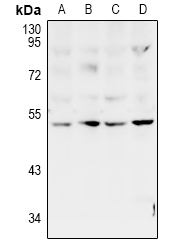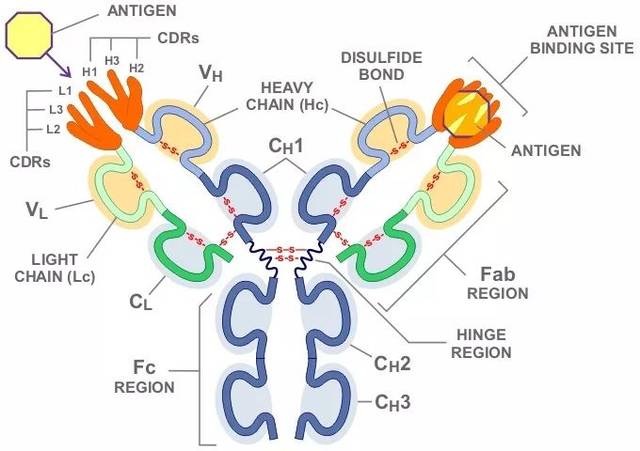Product Name :
ZAC polyclonal antibody Background :
Pleiomorphic adenoma gene (PLAG1) encodes a zinc finger protein and is the target gene for pleiomorphic adenomas of the salivary gland. The PLAG family of zinc finger proteins include PLAG1, ZAC1 and PLAG-like 2 (PLAGL2). ZAC1, also known as PLAGL1, concomitantly controls apoptosis and cell cycle arrest through separate pathways. ZAC1 also acts as a positive or negative transcriptional cofactor for nuclear receptors, depending on the expression of functional p53. ZAC1 is broadly expressed in embryo, with highest expression in the liver primordium, the umbilical region and the neural tube. PLAGL1 is also expressed in normal mammary gland. PLAGL2 functions as a positive regulator of transcription and localizes to the nucleus. PLAGL2 and ZAC1 bind to the DNA consensus sequence ACGGGGGCCCCTTTA. PLAGL2 is ubiquitously expressed with particular abundance in spleen, lung and testis where it may be involved in cell cycle arrest and apoptosis of tumor cells. Product :
Rabbit IgG, 1mg/ml in PBS with 0.02% sodium azide, 50% glycerol, pH7.2 Storage&Stability :
Store at 4°C short term. Aliquot and store at -20°C long term. Avoid freeze-thaw cycles. Specificity :
ZAC polyclonal antibody detects endogenous levels of ZAC protein. Immunogen :
Synthetic peptide, corresponding to Human ZAC. Conjugate :
Unconjugated Modification :
Unmodification
ZAC polyclonal antibody Background :
Pleiomorphic adenoma gene (PLAG1) encodes a zinc finger protein and is the target gene for pleiomorphic adenomas of the salivary gland. The PLAG family of zinc finger proteins include PLAG1, ZAC1 and PLAG-like 2 (PLAGL2). ZAC1, also known as PLAGL1, concomitantly controls apoptosis and cell cycle arrest through separate pathways. ZAC1 also acts as a positive or negative transcriptional cofactor for nuclear receptors, depending on the expression of functional p53. ZAC1 is broadly expressed in embryo, with highest expression in the liver primordium, the umbilical region and the neural tube. PLAGL1 is also expressed in normal mammary gland. PLAGL2 functions as a positive regulator of transcription and localizes to the nucleus. PLAGL2 and ZAC1 bind to the DNA consensus sequence ACGGGGGCCCCTTTA. PLAGL2 is ubiquitously expressed with particular abundance in spleen, lung and testis where it may be involved in cell cycle arrest and apoptosis of tumor cells. Product :
Rabbit IgG, 1mg/ml in PBS with 0.02% sodium azide, 50% glycerol, pH7.2 Storage&Stability :
Store at 4°C short term. Aliquot and store at -20°C long term. Avoid freeze-thaw cycles. Specificity :
ZAC polyclonal antibody detects endogenous levels of ZAC protein. Immunogen :
Synthetic peptide, corresponding to Human ZAC. Conjugate :
Unconjugated Modification :
Unmodification
-
 Western blot (WB) analysis of ZAC polyclonal antibody at 1:500 dilution LaneA:Hela whole cell lysate LaneB:U-87MG whole cell lysate LaneC:PC12 whole cell lysate LaneD:CT26 whole cell lysate
Western blot (WB) analysis of ZAC polyclonal antibody at 1:500 dilution LaneA:Hela whole cell lysate LaneB:U-87MG whole cell lysate LaneC:PC12 whole cell lysate LaneD:CT26 whole cell lysate
Bioworld Biotech only provide peptides for our antibodies and do not provide additional peptide customization services.
Price/Size :
USD 368/1mg/vial
Tips:
For phospho antibody, we provide phospho peptide(0.5mg) and non-phospho peptide(0.5mg).Describe :
Blocking peptides are peptides that bind specifically to the target antibody and block antibody binding. These peptide usually contains the epitope recognized by the antibody. Antibodies bound to the blocking peptide no longer bind to the epitope on the target protein. This mechanism is useful when non-specific binding is an issue, for example, in Western blotting (WB) and Immunohistochemistry (IHC). By comparing the staining from the blocked antibody versus the antibody alone, one can see which staining is specific; Specific binding will be absent from the western blot or IHC performed with the neutralized antibody.Formula:
Synthetic peptide was lyophilized with 100% acetonitrile and is supplied as a powder. Reconstitute with 0.1 ml DI water for a final concentration of 10 mg/ml.The purity is >90%,tested by HPLC and MS.
Storage:
The freeze-dried powder is more stable. For short time at 2-8°C. For long term storage store at -20°C.
Note :
This product is for research use only (RUO only). Not for use in diagnostic or therapeutic procedures.
 ZAC polyclonal antibody
ZAC polyclonal antibody  Datasheet
Datasheet COA
COA MSDS
MSDS SHIP
SHIP